
Newsletter of the Shell Club of Sydney
NSW Branch, The Malacological Society of Australasia Limited ACN 067 894 848
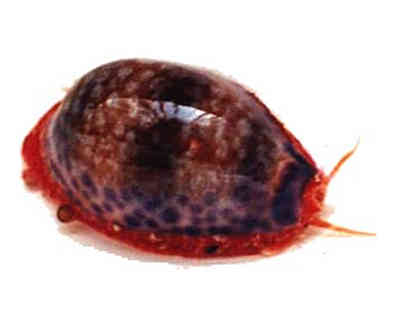
Cypraea chinensis live, Little Bay Sydney
Courtesy Chris & Karen Barnes
THE MOLLUSC FAUNA OF CALLALA BEACH, JERVIS BAY
By John Franklin
Callala Beach is located in the Peronian region, south of Nowra New South Wales on the beautiful south coast and almost in the centre of Jervis Bay.
The beach to the north extends to Callala Creek and in the south to Myola. Looking south from Callala Creek one can observe the magical white sand, sweeping curvaceously the full length of the beach, to where it finally joins the Eucumbene River at Myola.
Along the beach fringe there appears a host of Australian native plants including Eucalyptus, Banksias and amongst others, a little flower which resembles the honeysuckle. In fact, John Evans, the explorer and surveyor, in 1846 named the beach Honeysuckle Beach. However with the passage of time the beach became known eventually as Callala Beach.
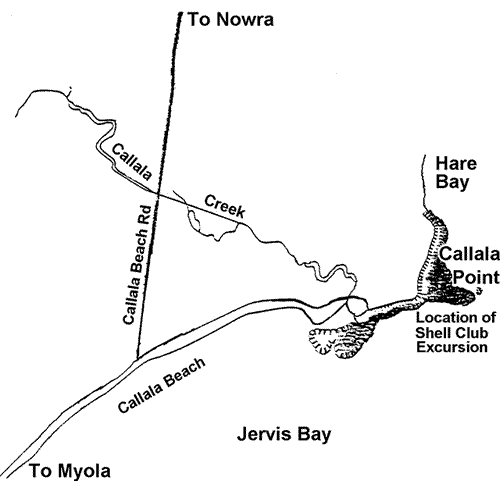
For some years there was debate over the derivation of the word 'Callala' in that the Aboriginal word for fish was "hallalla" and it so happened, that the birthplace of a prominent local convict was "Calala" in Ireland. Notwithstanding the debate, Callala Beach today stands as one of the most beautiful in the entire Jervis Bay area.
Mollusc fauna observations commenced in approximately 1993 initially on a casual basis and it has only been in the last 12 months that note taking and recording have been undertaken. In particular, the area was intensely studied on the 13, 14,15 and 16 April 2001.
An interesting feature of the area is it's complexity. At the northern end of the beach there are rock platforms which extend across sandy/mud flats located at the end of the beach and also north across the path of the Callala Creek. At low tide the creek area is surrounded by sandy mud flats, thus making it possible to observe the traditional sandy/mud flat dwellers such as, Pyrazus ebeninus (Bruguiere, 1792), Velacumantus australis (Quoy and Gaimard, 1834) and Tylozpera scutulata (Leach, 1814).
Callala Beach is not a real surf beach in that small waves incessantly break upon the beach bringing with them from time to time, lots of seaweed.
The purpose of the study was firstly to seek to identify by observation those species that inhabit the area. Secondly, to examine, over a period of time, as to whether or not there were any additions or indeed any absences in the number of species inhabiting the area. Thirdly, to use the observations as a background in the future for a study on the comparative analysis of mollusc fauna on a geographical distributional basis.
The observations were confined only to Gastropods and Bivalves:
Click Here to view Observations, and Full
Callala Lists
Conclusion
- Whilst a fair number of mollusc fauna were found to represent the two major Classes, there are still a number of species that remain yet to be identified. This problem arose particularly in the microscopic area involving families such as Triphoridae, Rissoidae, Pyramidellidae, Turridae and others.
- In 1997 and 1998 at certain periods through the year numbers of species of Bivalves were washed upon the beach. Other species were observed amongst the heavy seaweed. Whilst the periods of observation were somewhat limited, it can be said that there has been a decrease in the number of species washed up on the beach. In more recent times it appears that the mollusc fauna has become more concentrated towards the sandy/mud flat area adjoining Callala Creek.
- The above lists of Gastropods and Bivalves are not by any means exhaustive, more work needs to be done particularly in the identification of species under 10mm.
Cypraeidae of Little Bay; Update, May 2001
By Chris and Karen Barnes
Looking through a lever arch folder containing past "Shellers", I noticed it had been over a year since Karen and I wrote the article on Little Bay cowries. In that time I have observed and/or collected several species either not previously found alive, or recorded at all from this location. I thought it was about time we did so. I guess in chronological order the first addition to our list of Little Bay
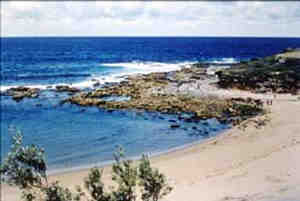
Figure 1 Southern Headland Little Bay NSW (rocky reef).
Cypraeidae was a specimen of Cypraea poraria Linnaeus, 1758. The shell was collected beneath a large rock at low tide on the 04/03/2000. The day was dull, overcast and stormy and the seas had been quite rough. The first stone I placed on its side was quite large and had an almost black cowry attached to its base. Initially I thought it was a reasonably common specimen of
Cypraea caputserpentis Linnaeus 1758 but when I picked it up and investigated further, I found a purple base and bright reddish mantle with many fine papillae being withdrawn into the shell. Interestingly, its 29mm length is at the very large end of the scale for this species, yet apparently not unusual for a number of species towards the southern end of their range in temperate waters. While discussing the shells' size with Des Beechey, he suggested parasitic worms could possibly have eaten the testes causing the shell to grow larger as occurs with castrated mammals such as steers. The aforementioned shell made an appearance at the 3rd National Shell Show, Adelaide. At the end of the show whilst packing up and taking photographs, Hugh Morrison noticed the specimen and advised me it would fade with time and of course he was absolutely right, it has faded markedly over the last year. Below are dorsum and base photos of the shell on the day it was collected, plus recent images showing how its depth of colour has lightened (faded) over the past year. These changes have occurred even though the shell has been stored in a dark place, away from any source of light whatsoever.
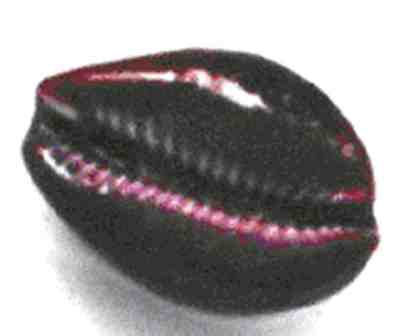
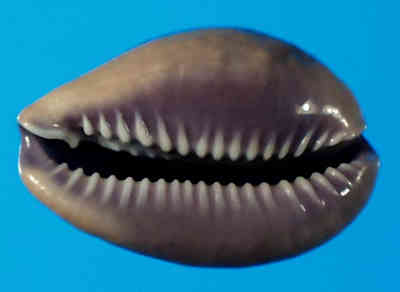
Figure 2/3 C. poraria live, then at 12 months
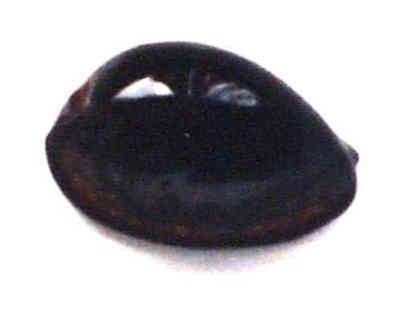
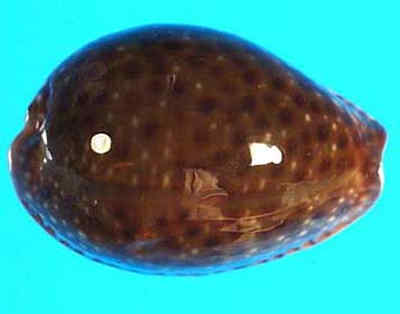
Figure 4/5 C. poraria live, then at 12 months
The second addition to our list is, Cypraea chinensis Gmelin, 1791. The specimen was found in the early afternoon on the 27/09/2000, a clear and bright sunny day, with an average low tide for collecting. It was found wandering in three hundred millimetres of water (one foot for the elderly) at the edge of a large boulder. The animal, a brilliant vermilion (scarlet) colour with mantle fully extended, was moving towards a sponge of a similar shade, or maybe a shade or two darker. The animal's mantle was decorated with wattle yellow coloured papillae, of a medium density throughout the mantle. When the mantle was withdrawn into the shell, there were three dark embryonal bands to be viewed through the dorsal netted pattern. The centre band being the largest and most visible, the yellow/tan reticulations forming clear lacunae, with a see through effect, via which the interior shell base colour of cream/blue could be seen. The shell, at forty-eight millimetres was the largest
C. chinensis we had ever seen (and the only live one). Its base had a glaze of violet/lavender on the columellar side with a central cream coloured patch, and many violet spots of varying size, moving closer to the margin. The outer lip had an orange/cream glaze, though the spaces (interstices) between the dentation ranged from orange to red/black. The columellar teeth were shorter and finer than the outer lips, which extended more than half way to the margin. Both margins were heavily calloused past two thirds of the way to the top, and cream/orange in colour. Both calloused margins were also very busy, overlaid with numerous varying sized violet spots. The anterior end callous was solid violet in colour. The posterior end callous was spotted with violet, and the spire appeared to be slightly depressed (umbilicate), though the callous seems to fill in and cover this in most other specimens I've seen.
In 1938 Schilder & Schilder named a sub species of C. chinensis they called
"sydneyensis", with its type locality as
Sydney Harbour. The characteristics were a more ovate shell than usual, less numerous but very coarse labial and columella dentation. Today authors consider
"sydneyensis" a synonym of C. chinensis. Myself, being born and residing in Sydney all my life, and very interested in the local marine fauna, find it all fascinating, and consider the "home town" name a very interesting piece of natural history.

Figure 6 C. chinensis live

Figure 7 C. chinensis today

Figure 8 C. chinensis live

Figure 9 C. chinensis, lateral callous today
The third addition to the list is Cypraea kieneri Hidalgo, 1906. Found recently, on the 08/04/2001. Located beneath a
small stone, at the low water mark, were a pair of cowries. The underside of the stone was covered with a patterned growth of what I believe was a sponge. The beige/cream coloured sponge was like a spider web except much thicker, radiating its reticulate form to cover the stones base. The cowries mantles were of an identical colour to the sponge, except for their mustard/orange tentacles and dark eye stalks, white filaments flaring from its stubby papillae and very tiny black specks dispersed throughout the mantles surface (only noticed when viewed via a dissecting microscope). The well defined blue/grey zones of dorsal patterning could be seen through the fully extended translucent mantles. One shell measured 16mm and the other 14mm, the base and sides are white. Both sides of each terminal end are blotched with very dark brown/black
The larger shell was a young adult with less developed dentation and had very few red/brown spots on the dorsum. The smaller of the two shells had dense red/brown spotting all over the dorsum and slightly darker and larger spotting laterally at each margin, it was certainly the more mature specimen. With this shells' quite well formed dentation in particular indicating a fully mature specimen. The three blue zones on both shells appear to have a red/brown outline/halo, this seems more obvious on the less mature shell, and I believe this is caused by layering of the dorsal pattern during growth/development.
One interesting observation was of the dentation viewed through the microscope. The central columella denticle was the
finest, with denticles gradually increasing in size/thickness moving towards either extremity from the mid denticle. The last five or six anteriorly do not extend across the base as the posterior columella dentation does.
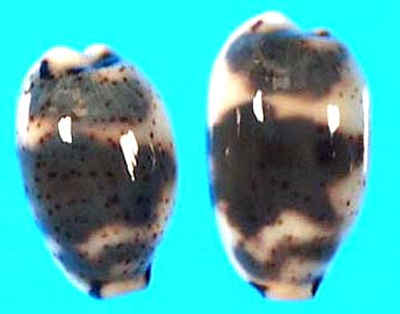
Figure 10 C. kieneri
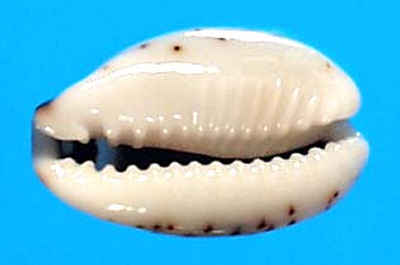
Figure 11 C. kieneri base of smaller specimen
The list as such stops growing at this point , though at least two species that were not previously observed alive, now have been. Which may not be as interesting as new additions, but it does alter their status in the table, which will follow.
Cypraea xanthodon Sowerby, 1822, previously only a couple of very dead specimens had been collected at this location. On the 13/10/2000 a juvenile was observed but at this stage we were unsure as to what species it was. A month later on the 11/11/2000 the same shell was observed beneath the same rock yet at that point it was very clear which species this cowry belonged to.
Our sub adult example of C. xanthodon was now twenty-five millimetres in length, with a velvety grey/green mantle and orange/amber papillae. Both posterior and anterior ends were pink/rose in colour and the immature dentation was a honey/gold in colour. Margins were glazed with pink/rose also, though deep brown spotting was beginning to form. Unfortunately we did not take the camera on this visit and have not rediscovered this shell since its release.
Cypraea gracilis Gaskoin, 1849, this species has been collected at this site previously, though not alive. The photographs below are of a live collected specimen found beneath a rock on the tide mark at dusk on the 17/12/2000. The animal was a translucent orange in colour, though I have seen reddish mantles for this species in various authors' books. I guess this demonstrates variability of form and environmental impact eg- food and habitat.
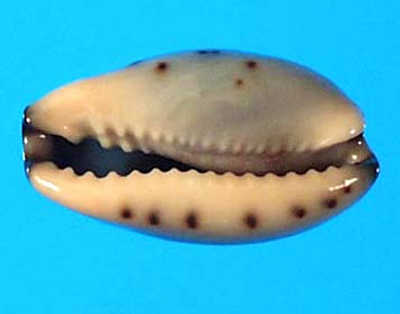
Figure 12 C. gracilis base.
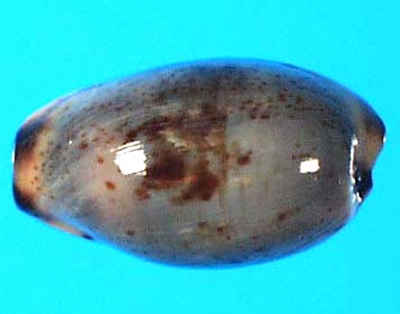
Figure 13 C. gracilis dorsum
As a footnote to the above article, I have collected an additional five species of Cypraeidae from in and around Sydney.
Cypraea hartsmithi (Schilder 1967) which is apparently a synonym of
Cypraea comptoni Gray 1847.
Cypraea helvola Linnaeus, 1758, I have not yet collected this species live in Sydney, but have a few beached specimens.
Cypraea subviridis Reeve 1835 Recently I collected a fine, very dark fresh dead example of this species. Just around the corner from Little Bay. The specimen has a large dark dorsal blotch and bands plus pink/lilac terminal ends and depressed spire.
Cypraea minoridens Melvill, 1901, I have a number of specimens, though the more I look at them the less sure I am that they are not
C. fimbriata.
Cypraea walkeri Sowerby, 1832. Over the years I have collected about half a dozen specimens. A fellow Sydney collector took a couple into the Museum some time ago and they were identified as sub fossil
C. walkeri.
At the February 2000 meeting of the NSW Branch of the MSA, I gave a presentation on Little Bay Cypraeidae. David Tarrant (from Coffs Harbour) was in Sydney, and attended the meeting. David had previously spent a great deal of time collecting in Sydney, so he was able to present me with a list of thirty-four Cypraea species he'd collected. Through discussions with Ashley Miskelly and Ernie Uhle, both keen Sydney cowry collectors with Sydney species numbers in the mid thirties, I believe it is conceivable a total of up to forty species could possibly be found in Sydney. I consider shell collecting is like golf, the more you practice the luckier you get. I realise that breeding populations probably do not exist, yet I'm sure we get a bigger number of northern visitors due to the prevailing coastal current than some people are prepared to believe.
The following table contains the Cypraeidae species found over the last 30 months during visits to Little Bay, Sydney, NSW.
Legend for Status :- A=Alive, D= Dead, FD=Fresh Dead, J=Juvenile,
Number, Species, Status, Occurrence Size
1 Cypraea annulus A seasonally common 29mm
2 Cypraea arabica A seasonally uncommon 55mm
3 Cypraea asellus A uncommon 21mm
4 Cypraea caputserpentis A common 43mm
5 Cypraea carneola FD uncommon 71mm
6 Cypraea caurica A uncommon 45mm
7 Cypraea cernica FD rare 20mm
8 Cypraea clandestina A common 19mm
9 Cypraea erosa FD seasonally uncommon 41mm
10 Cypraea errones A common 35mm
11 Cypraea felina A uncommon 22mm
12 Cypraea fimbriata A uncommon 12mm
13 Cypraea flaveola A moderately common 22mm
14 Cypraea gracilis A uncommon 18mm
15 Cypraea humphreysii A/J rare 13mm
16 Cypraea lynx A/J rare 15mm
17 Cypraea moneta A seasonally common 29mm
18 Cypraea teres A uncommon 35mm
19 Cypraea vitellus A common 55mm
20 Cypraea xanthodon A/J uncommon 26mm
21 Cypraea ziczac FD rare 21mm
22 Cypraea poraria A rare 29mm
23 Cypraea chinensis A rare 48mm
24 Cypraea kieneri A rare 16mm
Bibliography
1. Wilson, B.(1993) Australian Marine Shells Vol 1&2. Odyssey Publishing, Western Australia.
2. Coleman, N. (1981) What Shell Is That? 2nd Edition. Ure Smith Press, Hong Kong.
3. Allan, J. (1956) Cowry Shells Of World Seas. Georgian House Pty Ltd. Melbourne.
4. Wilson, B.R., Gillett, K. (1980) Australian Shells. A.H. & A. W. Reed Pty Ltd
5. Lorenz, F., Hubert, A. (1993) A Guide To Worldwide Cowries. Verlag Christa Hemmen, Wiesbaden, Germany.
All photography reproduced from originals by K. Barnes.
Sydney Harbour's hidden treasures
From news.com.au 21/5/01
By SIMON BENSON
Environment reporter
BIZARRE tropical fish, sharks, sea spiders, prehistoric prawns and sea horses. These are just some of the creatures that have been found to be lurking beneath the waters of Sydney Harbour.
A study has now revealed that the 40m-deep waterway has one of the most diverse marine environments of any harbour in the world.
Exclusive pictures taken by underwater photographer Arkos Lumnitzer reveal the contrast between what seems like a marine desert from the surface and what actually lies beneath.
About 600 species, including the rare weedy sea dragon and a previously unknown species of pipehorse, have now been described by marine biologists at the Australian Museum.
Added to this is an estimated 2000 marine invertebrates, including prawns from the Jurassic Age, sea spiders the size of a human hand and sea slugs. An eel which burrows into the sand -- which could be new to science -- has also been discovered.
The last complete survey of Sydney Harbour was conducted in the 1970s by Australian Museum ichthyologist John Paxton who estimated about 500 fish species. More recently, researchers have added at
least another 100 species to that list -- many of which have come as a complete scientific surprise.
"Most people don't have a clue about what's in the harbour," said museum marine biologist Brooke Carson-Ewart.
"We were even surprised by some of the things we found. We now believe that Sydney has the most diverse fish fauna of any harbour in the world."
Some of the fish species that have bewildered biologists include the indian red fish, pineapple fish, scorpion fish, ghost pipe fish, sea dragons and the discovery of the bizarre angler fish.
The discoveries have prompted the launch of a major exhibition of Sydney Harbour and its marine diversity to be held at the Australian Museum in July. Ms Carson-Ewart claimed five different marine environments had been identified in the harbour -- rocky reef shelves, mangroves, intertidal zones, kelp beds and sea grass.
While most of the diversity of species are concentrated around Manly, eastern suburbs and the heads, Parramatta River also provided habitat for fish breeding. This, combined with the fact that Sydney Harbour was a very deep port and was on the border of tropical and temperate marine climates, had provided the perfect marine ecosystem.
Minutes 28/04/2001
The meeting was opened by P. Jansen at 2:03pm.
Field Trip Reports
Michael Keats reported on the recent field trip to Hawks Nest. Michael mentioned that conditions were overcast as he set out, but the weather had turned around to be fine on arrival. Yacaaba Head to the south was to produce some quality shell grit and larger specimens wedged between rocks, but these were quite eroded, eg-
Amoria undulata (Lamarck, 1804), Cymbiolista hunteri Iredale, 1931,
Cymbiola magnifica (Gebauer, 1802).
Steve Dean reported investigating the Port Stephens side of the headland, finding some live species though not many, as the rocky environment smashed up most shells with the wave action. Ron Moylan reported that when he visited Hawks Nest the previous week there were large schools of mullet running. M. Keats also reported on a visit to Huskisson, where he was able to collect some fine shell grit. Michael also mentioned that he'd enjoyed the Dolphin Boat cruise on Jervis Bay to Point Perpendicular (the northern headland at the entrance to Jervis Bay).
Ashley Miskelly reported on another visit to Bottle and Glass Rocks in Sydney Harbour. Among Ashley's finds was a specimen of
Maoricolpus roseus (Quoy & Gaimard, 1834) a species from New Zealand. Other interesting finds included : -
Haliotis brazieri Angas, 1859, Haliotis hargravesi Cox, 1869,
Cypraea subviridis Reeve, 1835
Cypraea xanthodon Sowerby, 1822, Cypraea gracilis Gaskoin 1849 and a large urchin and Pinna.
Patty Jansen reported on two field trips, one to Patonga & Pearl beach, though there were few shells about, Umina was found to be a good picnic spot. Trip number two was to Chinamans Beach and Balmoral headland. Patty commented that the grit was so rich, she imagined the snorkelling and diving should be incredible.
New Acquisitions
M. Keats reported that an old collection of shells from Garden Island had come into his possession, a gift from an ex-dockyard worker's daughter. Apparently some of the specimens had come from the excavation of the dry dock.
New Books
P. Jansen passed around the Oct-Dec 2000 issue of La Conchiglia. Patty also circulated a book by Alan G. Jarrett titled "Sea Shells of The Seychelles", the book contains six hundred species, individually photographed.
General Business
Chris Barnes read a letter from David and Elizabeth Woodhouse regarding their new address and up coming trip to Western Australia. R. Moylan reported on a friends boat which had become stuck on reef in the Solomons. Ron also display the front cover of the Northern Beaches "Weekender" which contained a photograph and article about Phil Colman. It was noted that Io's obituary appeared in the Sydney Morning Herald on April 24th. Io is greatly missed by the group and her efforts still appreciated. M. Keats displayed a folder on "Protecting Sydney Wetlands" put together by the Protecting Wetlands Steering Committee and in association with Local Councils Development Control Plan. The Proposal would force change to planning approvals. Hopefully seeing run off control implemented, eg- retention bays ($7,000) to prevent damage to wetland environments.
Presentation
Ashley Miskelly gave a slide presentation on Marine Photographic Techniques.
Ashley stated that his talk would be along the lines of what not to do rather than what to do. Demonstrating the result of faux pas he had made during his experience, hopefully so as others could glean some knowledge. Points covered included exposures, backgrounds, aquariums, shadows, field and distractions, SLR's, macro lenses, stands and tripods and of course Ashley's favourite, large numbers of urchins encompassing all shapes and sizes. Ashley answered many questions from the group and no one fell asleep during lights out (just joking), it was a colourful and enlightening demonstration of technique.
Meeting closed at 3.30pm
Auction :- M. Keats assumed the role of auctioneer and Thora Whitehead's donation, a book titled "South East Asian Conus" by Lim & Wee was purchased by Steve Dean for forty dollars.
C. & K. Barnes
Secretary
|














